Effect of Capacity Variation in Series-Connected Batteries on Aging
Abstract
:1. Introduction
2. Characteristics of Battery Connection Structure
2.1. Characteristics of Series-Connected Batteries
2.2. Charging/Discharging Characteristics of Series-Connected Batteries and Ideal Aging
2.3. Aging of Series-Connected Batteries during Charging and Discharging
3. Proposed Cell-Balancing Method
3.1. Causes of Voltage Distribution
3.2. Review of the Proposed Cell-Balancing Plan
4. Simulation Results
4.1. Simulation Result of the Proposed Cell-Balancing Method
4.2. Comparison of Standard Simulation Result
5. Conclusions
Author Contributions
Funding
Institutional Review Board Statement
Informed Consent Statement
Data Availability Statement
Conflicts of Interest
References
- Carbon Footprint. Available online: https://www.carbonfootprint.com/ (accessed on 16 June 2022).
- Hur, J.; Jeon, S.; Kim, J.Y. A trend of US Air-Conditioning and Off-cycle credit system to reduce Mobile Greenhouse Gas. In Proceedings of the KSAE 2013 Annual Autumn Conference & Exhibition, Seoul, Republic of Korea, 15 November 2013; pp. 399–403. [Google Scholar]
- Ananda, S.; Lakshminarasamma, N.; Radhakrishna, V.; Srinivasan, M.S.; Satyanarayana, P.; Sankaran, M. Generic Lithium ion battery model for energy balance estimation in spacecraft. In Proceedings of the 2018 IEEE International Conference on Power Electronics, Drives and Energy Systems (PEDES), Chennai, India, 18–21 December 2018; pp. 1–5. [Google Scholar] [CrossRef]
- Zheng, L.; Zhu, J.; Wang, G. A comparative study of battery balancing strategies for different battery operation processes. In Proceedings of the 2016 IEEE Transportation Electrification Conference and Expo (ITEC), Dearborn, MI, USA, 27–29 June 2016; pp. 1–5. [Google Scholar] [CrossRef]
- Pinto, C.; Barreras, J.V.; Schaltz, E.; Araujo, R.E. Evaluation of Advanced Control for Li-ion Battery Balancing Systems Using Convex Optimization. IEEE Trans. Sustain. Energy 2016, 7, 1703–1717. [Google Scholar] [CrossRef]
- Omariba, Z.B.; Zhang, L.; Sun, D. Review of Battery Cell Balancing Methodologies for Optimizing Battery Pack Performance in Electric Vehicles. IEEE Access 2019, 7, 129335–129352. [Google Scholar] [CrossRef]
- Feng, F.; Hu, X.; Liu, K.; Che, Y.; Linc, X.; Jin, G.; Liu, B. A Practical and Comprehensive Evaluation Method for Series-Connected Battery Pack Models. IEEE Trans. Transp. Electrif. 2020, 6, 391–416. [Google Scholar] [CrossRef]
- Iraola, U.; Aizpuru, I.; Gorrotxategi, L.; Segade, J.M.C.; Larrazabal, A.E.; Gil, I. Influence of Voltage Balancing on the Temperature Distribution of a Li-Ion Battery Module. IEEE Trans. Energy Convers. 2014, 30, 507–514. [Google Scholar] [CrossRef]
- Sertkaya, M.G.; Yilmaz, E.; Sanli, A.E.; Gunli, G. Comparison of power and energy density after full shunting-balancing in serial connected lithium-ion batteries and serial-connected supercapacitors. In Proceedings of the 2015 3rd International Renewable and Sustainable Energy Conference (IRSEC), Marrakech, Morocco, 10–13 December 2015; pp. 1–5. [Google Scholar] [CrossRef]
- Song, Y.; Liu, D.; Peng, Y. Series-connected lithium-ion battery pack health modeling with cell inconsistency evaluation. In Proceedings of the 2019 IEEE International Instrumentation and Measurement Technology Conference (I2MTC), Auckland, New Zealand, 20–23 May 2019; pp. 1–6. [Google Scholar] [CrossRef]
- Feng, W.; Jiuchun, J.; Weige, Z.; Huiping, G. Research on the charge mode of series-connected batteries. In Proceedings of the 2008 IEEE Vehicle Power and Propulsion Conference, Harbin, China, 3–5 September 2008; pp. 1–5. [Google Scholar] [CrossRef]
- Chuang, C.-C.; Yao, C.-J.; Wu, S.-T. Study on Fast Charging Method of Series Connected Lithium-Ion Battery Strings with Intelligent Control. In Proceedings of the 2020 International Conference on Fuzzy Theory and Its Applications (iFUZZY), Hsinchu, Taiwan, 4–7 November 2020; pp. 1–6. [Google Scholar] [CrossRef]
- Yang, X.; Ma, E.W.M.; Pecht, M. Cell balancing technology in battery packs. In Proceedings of the 2012 13th International Conference on Electronic Packaging Technology & High Density Packaging, Guilin, China, 13–16 August 2012; pp. 1038–1041. [Google Scholar] [CrossRef]
- Pham, V.-L.; Nguyen, T.-T.; Tran, D.-H.; Vu, V.-B.; Choi, W. A new cell-to-cell fast balancing circuit for Lithium-Ion batteries in Electric Vehicles and Energy Storage System. In Proceedings of the 2016 IEEE 8th International Power Electronics and Motion Control Conference (IPEMC-ECCE Asia), Hefei, China, 22–26 May 2016; pp. 2461–2465. [Google Scholar] [CrossRef]
- Kim, J.; Lee, S.J.; Lee, J.M.; Cho, B.H. The Characteristics Analysis of Li-Ion Fresh Battery for Temperature. In Proceedings of the Power Electronics Conference, Seoul, Republic of Korea, 30 November 2007; pp. 66–68. [Google Scholar]
- Yun, S.S.; Kee, S.-C. Relaxation Time for Temperature Change of Lithium Ion Battery. In Proceedings of the Korean Society of Automotive Engineers Spring Conference, Chungcheongnam-do, Republic of Korea, 2–4 July 2019; pp. 1148–1154. [Google Scholar]
- Chowdhury, S.; Bin Shaheed, M.N.; Sozer, Y. An Integrated State of Health (SOH) Balancing Method for Lithium-Ion Battery Cells. In Proceedings of the 2019 IEEE Energy Conversion Congress and Exposition (ECCE), Baltimore, MD, USA, 29 September–3 October 2019; pp. 5759–5763. [Google Scholar] [CrossRef]
- Zhang, Y.; Lu, S. Research on Series-Parallel Connection Switching Charging Method for Lithium Battery of Autonomous Underwater Vehicles. In Proceedings of the 2018 IEEE 8th International Conference on Underwater System Technology: Theory and Applications (USYS), Wuhan, China, 1–3 December 2018; pp. 1–5. [Google Scholar] [CrossRef]
- Zhang, Z.; Cheng, X.; Lu, Z.-Y.; Gu, D.-J. SOC Estimation of Lithium-Ion Battery Pack Considering Balancing Current. IEEE Trans. Power Electron. 2017, 33, 2216–2226. [Google Scholar] [CrossRef]
- Stroe, D.-I.; Swierczynski, M.; Stan, A.-I.; Teodorescu, R.; Andreasen, S.J. Accelerated Lifetime Testing Methodology for Lifetime Estimation of Lithium-Ion Batteries Used in Augmented Wind Power Plants. IEEE Trans. Ind. Appl. 2014, 50, 4006–4017. [Google Scholar] [CrossRef]
- Kwang-seok, S.; Park, S.-J. Battery Charging System with Built-in ACIR Measurement Algorithm using Peak Detection Circuit and DFT. Ph.D. Thesis, Chonnam National University, Gwangju, Republic of Korea, 2021. [Google Scholar]
- Wu, C.-Y.; Ke, C.-H.; Chang, C.-L.; Chiou, Z.-Y. Useful life characteristics of a LiFePO4 battery for estimating state of battery health. In Proceedings of the 2018 IEEE International Conference on Applied System Invention (ICASI), Chiba, Japan, 13–17 April 2018; pp. 1338–1341. [Google Scholar] [CrossRef]
- Celen, B.; Aras, A.C.; Dohr, M.; Sivaraman, T. Equivalent Circuit Modeling of All-Solid-State Battery by using DC-IR Data. In Proceedings of the 2021 IEEE International Systems Conference (SysCon), Vancouver, BC, Canada, 15 April–15 May 2021; pp. 1–6. [Google Scholar] [CrossRef]
- Rizzello, A.; Scavuzzo, S.; Ferraris, A.; Airale, A.G.; Carello, M. Temperature-Dependent Thévenin Model of a Li-Ion Battery for Automotive Management and Control. In Proceedings of the 2020 IEEE International Conference on Environment and Electrical Engineering and 2020 IEEE Industrial and Commercial Power Systems Europe (EEEIC/I&CPS Europe), Madrid, Spain, 9–12 June 2020; pp. 1–6. [Google Scholar] [CrossRef]
- Yu, L.-R.; Hsieh, Y.-C.; Liu, W.-C.; Moo, C.-S. Balanced discharging for serial battery power modules with boost converters. In Proceedings of the 2013 International Conference on System Science and Engineering (ICSSE), Budapest, Hungary, 4–6 July 2013; pp. 449–453. [Google Scholar] [CrossRef]
- Wang, Y.; Tan, J. A Hybrid Clustering Model for Lithium-ion Batteries Screening. In Proceedings of the 2019 IEEE 5th International Conference on Computer and Communications (ICCC), Chengdu, China, 6–9 December 2019; pp. 120–124. [Google Scholar] [CrossRef]
- Yang, R.; Xiong, R.; Shen, W. On-board soft short circuit fault diagnosis of lithium-ion battery packs for electric vehicles using extended Kalman filter. CSEE J. Power Energy Syst. 2020, 8, 258–270. [Google Scholar] [CrossRef]
- ISL78610 Multi-Cell Li-Ion Battery Manager Datasheet. Available online: https://www.renesas.com/us/en/document/dst/isl78610-datasheet?r=496881 (accessed on 10 June 2022).
- Hsieh, Y.-C.; Lo, C.-Y.; Chen, P.-C.; Chiu, H.-J. Charge Equalization on Series-Connected Battery Modules by Digital Controller. In Proceedings of the 2019 IEEE 4th International Future Energy Electronics Conference (IFEEC), Singapore, 25–28 November 2019. [Google Scholar] [CrossRef]
- Yun, S.S.; Kee, S.C. Analysis of the Cell Balancing Effect on the ESS Fire by Simulating the Euljiro 3-Ga Subway ESS. Trans. Korean Inst. Power Electron. 2020, 25, 219–226. [Google Scholar] [CrossRef]
- Hosseinzadeh, E.; Odio, M.X.; Marco, J.; Jennings, P. Unballanced Performance of Parallel Connected Large Format Lithium Ion Batteries for Electric Vehicle Application. In Proceedings of the 2019 International Conference on Smart Energy Systems and Technologies (SEST), Porto, Portugal, 9–11 September 2019; pp. 1–6. [Google Scholar] [CrossRef] [Green Version]
- Lee, S.; Kim, J.; Ha, M.; Song, H. Inrush Current Estimation for Hot Swap of the Parallel Connected Large Capacity Battery Pack. In Proceedings of the 2018 IEEE Energy Conversion Congress and Exposition (ECCE), Portland, OR, USA, 23–27 September 2018; pp. 2489–2492. [Google Scholar] [CrossRef]
- Kee, S.-C.; Yun, S.S. Energy Storage System Safety Operation Plan by Preventing Overcharge During Relaxation Time. J. Electr. Eng. Technol. 2021, 16, 1941–1953. [Google Scholar] [CrossRef]
- Kwon, S.; Han, D.; Lee, S.; Song, H.-C.; Kim, J. Voltage deviation analysis for battery pack Aging. In Proceedings of the Power Electronics Conference, Chungcheongnam-do, Republic of Korea, 2–4 July 2019; pp. 451–452. [Google Scholar]
- Lu, R.; Zhu, C.; Tian, L.; Wang, Q. Super-Capacitor Stacks Management System with Dynamic Equalization Techniques. IEEE Trans. Magn. 2006, 43, 254–258. [Google Scholar] [CrossRef]
- Yun, S.-S.; Kee, S.-C. Improved Multilevel Multistage Constant-Current Constant-Voltage Superfast Charging of Multiple Cells. J. Electr. Eng. Technol. 2021, 17, 209–219. [Google Scholar] [CrossRef]



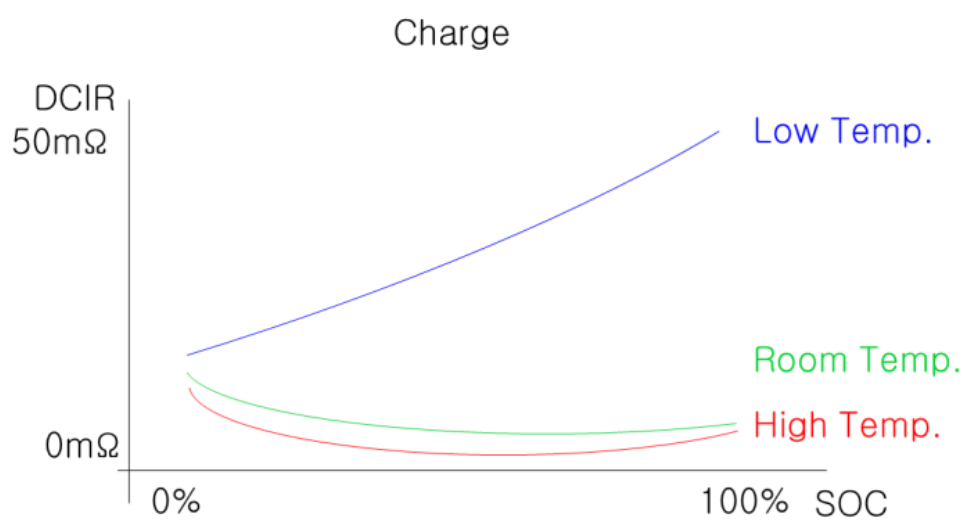



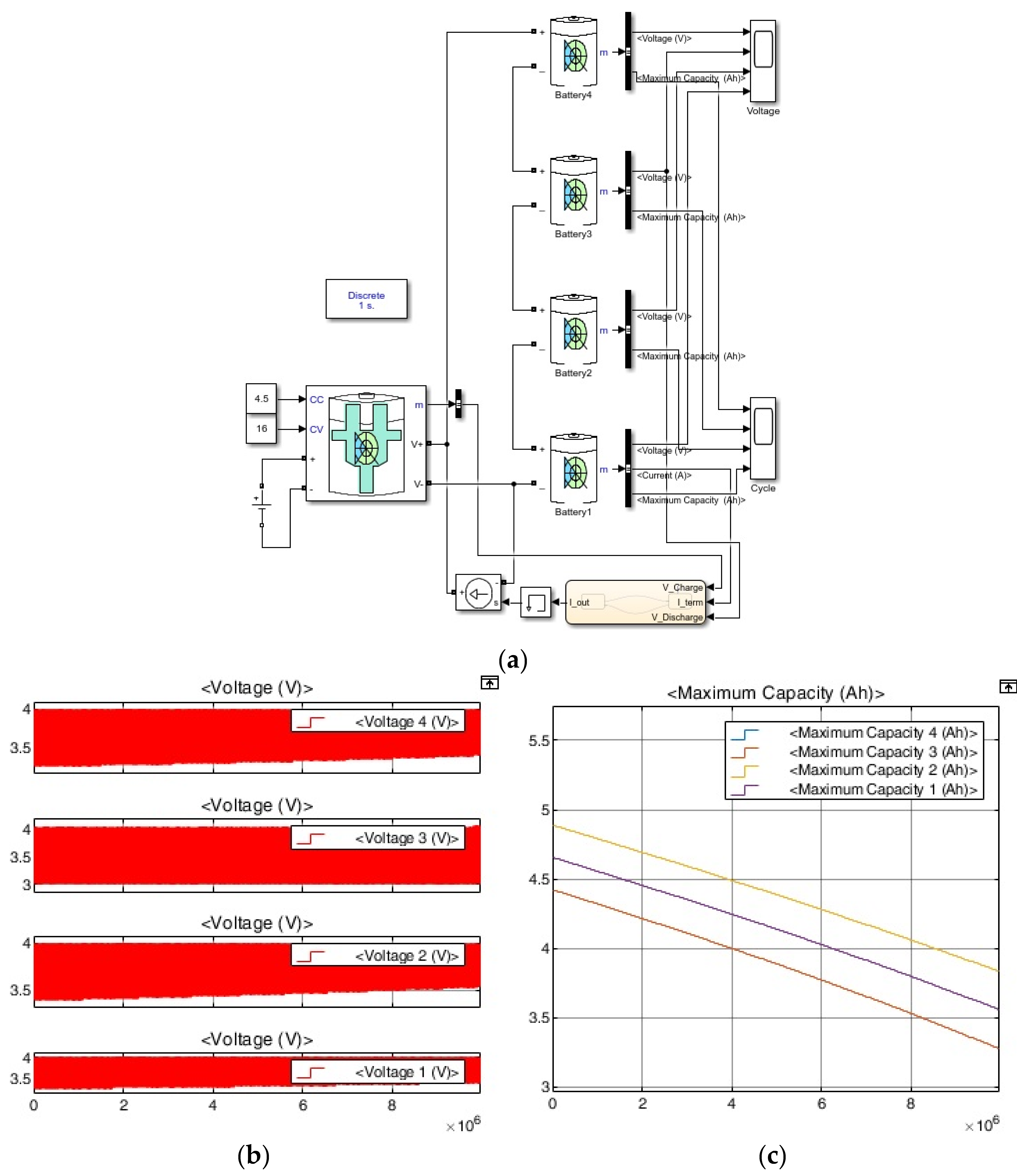

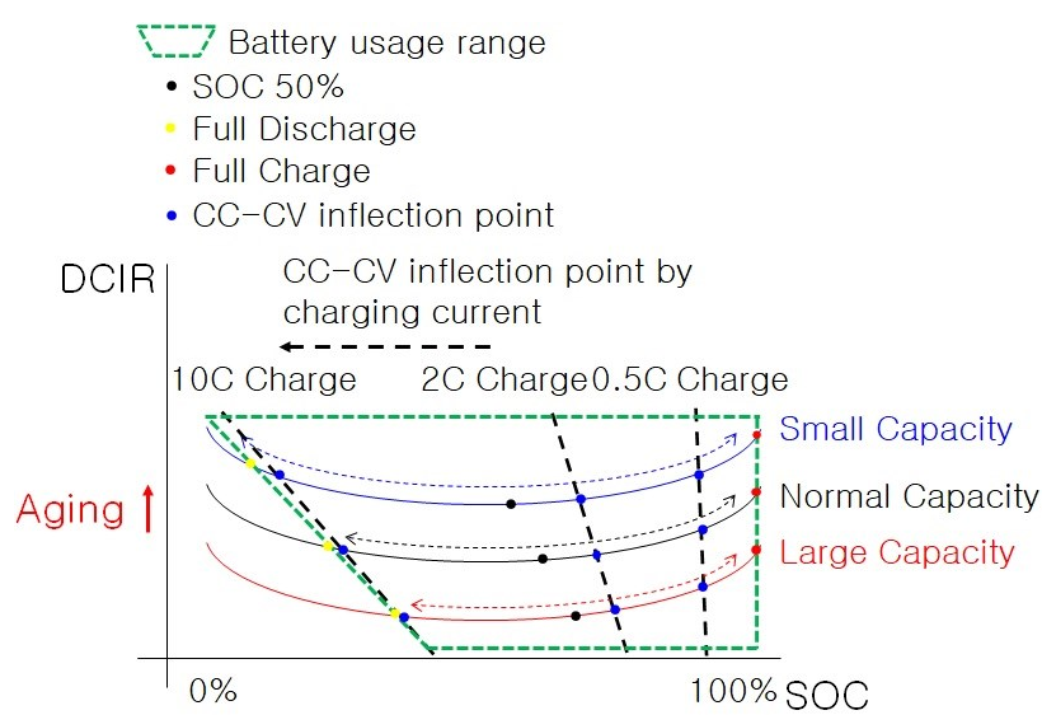
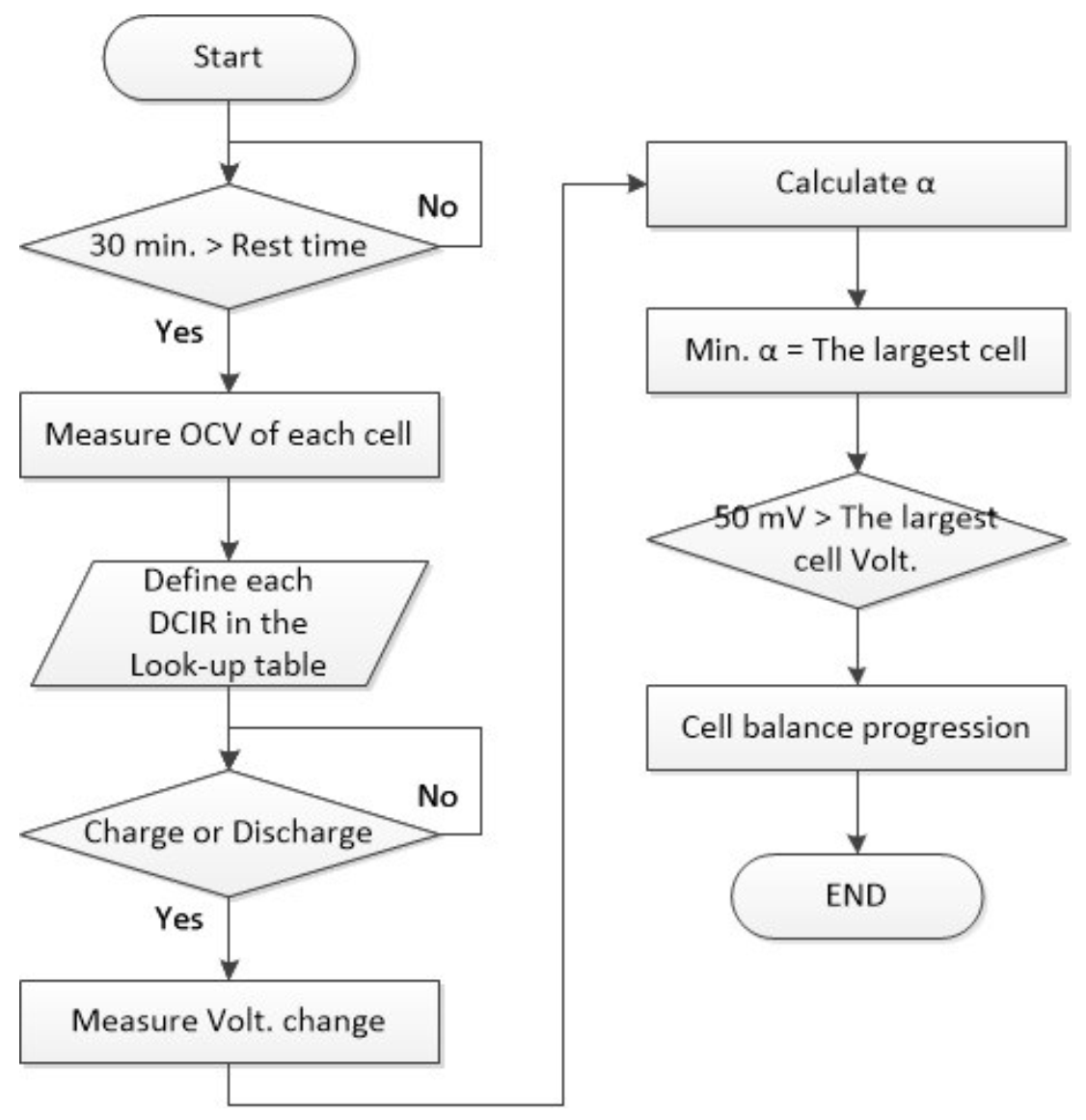


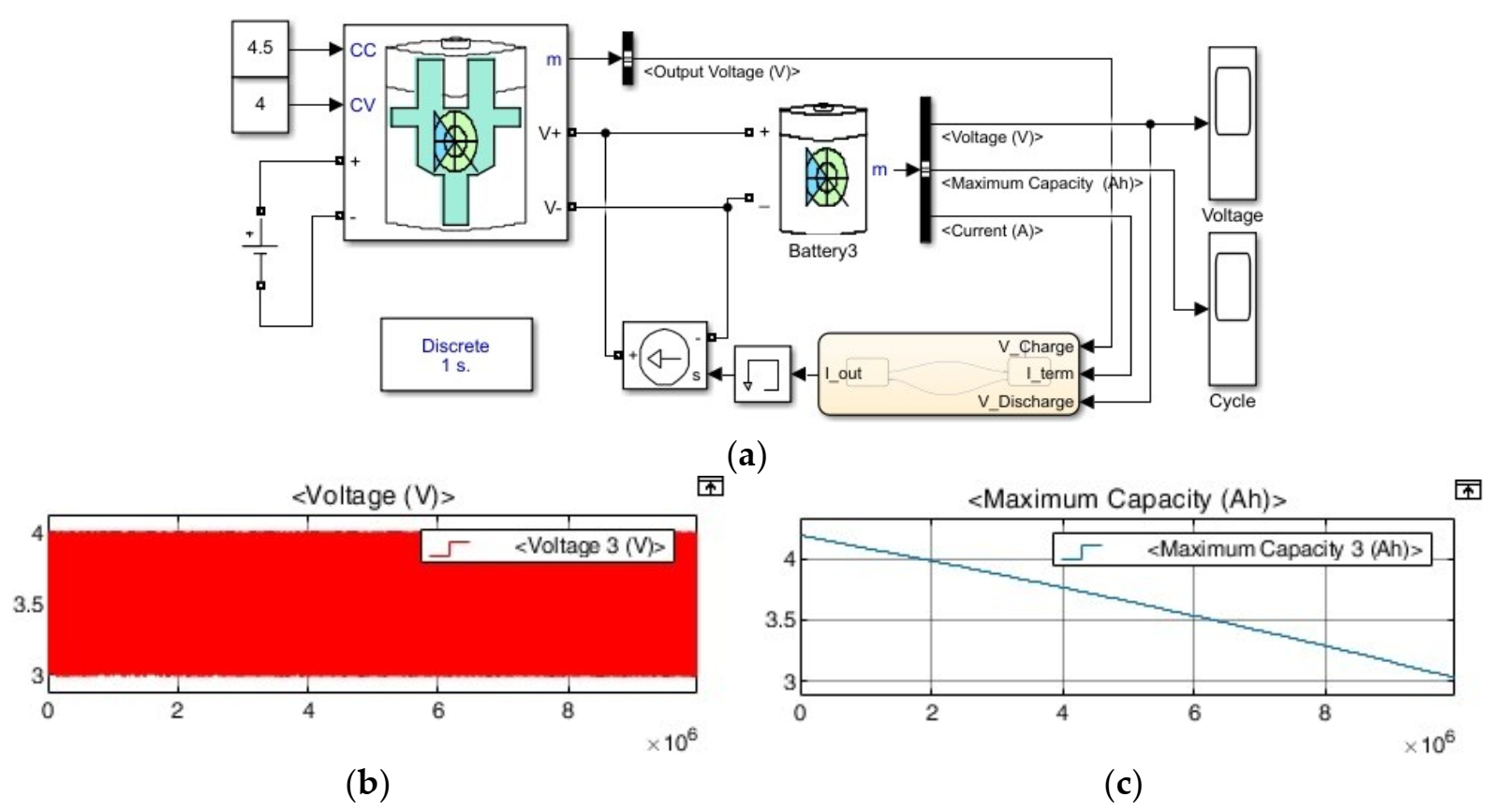
| ITEM | Cell #1 | Cell #2 | Cell #3 | Cell #4 |
|---|---|---|---|---|
| Max. Volt. | 4.107 V | 4.088 V | 4.327 V | 4.107 V |
| Max. Volt. Deviation | 239 mV | |||
| Min. Volt. | 3.209 V | 3.336 V | 2.999 V | 3.209 V |
| Min. Volt. Deviation | 337 mV | |||
| Item | Cell #1 | Cell #2 | Cell #3 | Cell #4 | |
|---|---|---|---|---|---|
| Time | 0 s | 4.653 Ah | 5.118 Ah | 4.188 Ah | 4.653 Ah |
| 1 × 107 s | 3.494 Ah | 3.843 Ah | 3.145 Ah | 3.494 Ah | |
| Capacity change | 1.159 Ah | 1.275 Ah | 1.043 Ah | 1.159 Ah | |
| Rate of change | 24.91% | 24.91% | 24.90% | 24.91% | |
| Max. Volt. | 4.007 V | 4.007 V | 4.007 V | 4.007 V | |
| Max. Volt. Deviation | 0 mV | ||||
| Min. Volt. | 2.994 V | 2.994 V | 2.994 V | 2.994 V | |
| Min. Volt. Deviation | 0 mV | ||||
| Item | Cell #1 | Cell #2 | Cell #3 | Cell #4 | |
|---|---|---|---|---|---|
| Time | 0 s | 4.653 Ah | 4.886 Ah | 4.420 Ah | 4.653 Ah |
| 1 × 107 s | 3.556 Ah | 3.831 Ah | 3.273 Ah | 3.556 Ah | |
| Capacity change | 1.097 Ah | 1.055 Ah | 1.147 Ah | 1.097 Ah | |
| Rate of change | 23.58% | 21.59% | 25.95% | 23.58% | |
| Max. Volt. | 4.005 V | 3.997 V | 4.042 V | 4.005 V | |
| Max. Volt. Deviation | 45 mV | ||||
| Min. Volt. | 3.254 V | 3.392 V | 2.994 V | 3.254 V | |
| Min. Volt. Deviation | 398 mV | ||||
| Item | Cell #1 | Cell #2 | Cell #3 | Cell #4 | |
|---|---|---|---|---|---|
| Time | 0 s | 4.653 Ah | 5.118 Ah | 4.188 Ah | 4.653 Ah |
| 1 × 107 s | 3.575 Ah | 4.118 Ah | 3.007 Ah | 3.575 Ah | |
| Capacity change | 1.078 Ah | 1.001 Ah | 1.181 Ah | 1.078 Ah | |
| Rate of change | 23.17% | 19.56% | 28.20% | 23.17% | |
| Max. Volt. | 4.004 V | 3.990 V | 4.085 V | 4.004 V | |
| Max. Volt. Deviation | 95 mV | ||||
| Min. Volt. | 3.396 V | 3.542 V | 2.994 V | 3.396 V | |
| Min. Volt. Deviation | 548 mV | ||||
| ITEM | Capacity Change Rate (%) | |||
|---|---|---|---|---|
| Cell #1 | Cell #2 | Cell #3 | Cell #4 | |
| Individual charging (1) | 24.91% | 24.91% | 24.90% | 24.91% |
| ±5% deviation Single power charging (2) | 23.85% | 21.59% | 25.95% | 23.58% |
| ±10% deviation Single power charging (3) | 23.17% | 19.56% | 28.20% | 23.17% |
| (1)–(2) Rate of Change | 1.33% | 3.32% | −1.05% | 1.33% |
| (1)–(3) Rate of Change | 1.74% | 5.35% | −3.30% | 1.74% |
| Aging progress | Deceleration | Deceleration | Acceleration | Deceleration |
| ITEM | Cell #1 | Cell #2 | Cell #3 | Cell #4 |
|---|---|---|---|---|
| Max. Volt. | 4.130 V | 4.132 V | 4.130 V | 4.130 V |
| Max. Volt. Deviation | 2 mV | |||
| Min. Volt. | 3.337 V | 3.486 V | 2.999 V | 3.337 V |
| Min. Volt. Deviation | 487 mV | |||
| Item | Cell #1 | Cell #2 | Cell #3 | Cell #4 | |
|---|---|---|---|---|---|
| Time | 0 s | 4.653 Ah | 5.118 Ah | 4.188 Ah | 4.653 Ah |
| 1 × 107 s | 3.620 Ah | 4.185 Ah | 3.020 Ah | 3.620 Ah | |
| Capacity change | 1.033 Ah | 0.933 Ah | 1.168 Ah | 1.033 Ah | |
| Rate of change | 22.20% | 18.17% | 27.89% | 22.20% | |
| Max. Volt. | 4.007 V | 4.006 V | 4.010 V | 4.007 V | |
| Max. Volt. Deviation | 4 mV | ||||
| Min. Volt. | 3.549 V | 3.676 V | 2.994 V | 3.549 V | |
| Min. Volt. Deviation | 682 mV | ||||
| Item | Single Cell (Cell #3) | Series-Connected Battery Existing Cell Balance (Cell #3) | Proposed Cell Balance for Series-Connected Batteries (Cell #3) | |
|---|---|---|---|---|
| Time | 0 s | 4.188 Ah | 4.188 Ah | 4.188 Ah |
| 1 × 107 s | 3.025 Ah | 3.007 Ah | 3.020 Ah | |
| Capacity change | 1.163 Ah | 1.181 Ah | 1.168 Ah | |
| Rate of change | 27.77% | 28.20% | 27.89% | |
| Max. Volt. | 4.006 V | 4.085 V | 4.010 V | |
| Min. Volt. | 2.994 V | 2.994 V | 2.994 V | |
Disclaimer/Publisher’s Note: The statements, opinions and data contained in all publications are solely those of the individual author(s) and contributor(s) and not of MDPI and/or the editor(s). MDPI and/or the editor(s) disclaim responsibility for any injury to people or property resulting from any ideas, methods, instructions or products referred to in the content. |
© 2022 by the authors. Licensee MDPI, Basel, Switzerland. This article is an open access article distributed under the terms and conditions of the Creative Commons Attribution (CC BY) license (https://creativecommons.org/licenses/by/4.0/).
Share and Cite
Yun, S.-S.; Kee, S.-C. Effect of Capacity Variation in Series-Connected Batteries on Aging. Batteries 2023, 9, 22. https://doi.org/10.3390/batteries9010022
Yun S-S, Kee S-C. Effect of Capacity Variation in Series-Connected Batteries on Aging. Batteries. 2023; 9(1):22. https://doi.org/10.3390/batteries9010022
Chicago/Turabian StyleYun, Sang-Sun, and Seok-Cheol Kee. 2023. "Effect of Capacity Variation in Series-Connected Batteries on Aging" Batteries 9, no. 1: 22. https://doi.org/10.3390/batteries9010022








